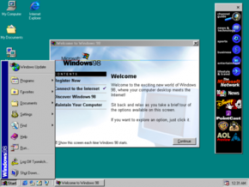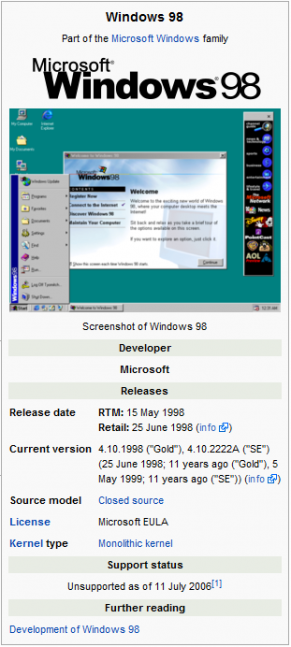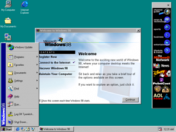Download illegally
SO: http://www.megaupload.com/?d=QUIHOUTN
KEY: DMWRC-T9XP4-GJ2P8-26G66-V9WBB
VHD: http://www.megaupload.com/?d=Z36SEWRG
INFO: http://da.wikipedia.org/wiki/Windows_98
Upgrade: http://www.4shared.com/file/254158337/37bbaee2/Microsoft_Plus_98.html
Windows 98

Windows 98 (codenamed Memphis) is a graphical operating system by Microsoft. It was released to manufacturing on May 15, 1998 and to retail on June 25, 1998. Windows 98 is the successor to Windows 95. Like its predecessor, it is a hybrid 16-bit/32-bit monolithic product with anMS-DOS based boot loader. Windows 98 was succeeded by Windows Me on September 14, 2000. Microsoft support for Windows 98 ended on July 11, 2006.
New driver standardsWindows 98 was the first operating system to use the Windows Driver Model (WDM). This fact was not well published when Windows 98 was released and most hardware producers continued to develop drivers for the older driver standard, VxD. The WDM standard spread years after its release, mostly through Windows 2000 and Windows XP, because these systems are not compatible with the older VxD standard[2]. Today, even if hardware producers are not developing drivers optimized for Windows 98, the drivers written to WDM standards are compatible with Windows 98-based systems.
Windows 98 System tools
New driver standardsWindows 98 was the first operating system to use the Windows Driver Model (WDM). This fact was not well published when Windows 98 was released and most hardware producers continued to develop drivers for the older driver standard, VxD. The WDM standard spread years after its release, mostly through Windows 2000 and Windows XP, because these systems are not compatible with the older VxD standard[2]. Today, even if hardware producers are not developing drivers optimized for Windows 98, the drivers written to WDM standards are compatible with Windows 98-based systems.
Windows 98 System tools
- ScanDisk — System utility used to maintain the file system. It offers a DOS and a GUI version. used to check the integrity of the file system and files stored within[6].
- Disk Defragmenter — Used to counter the negative effects of filesystem fragmentation. It collects fragmented file parts, reconnects them and rearranges all files in optimal order, thus speeding up file access and allowing faster boot times.[6][7]
- Scanreg — Used to restore the System registry. It tests the registry's integrity and saves a backup copy each time. The maximum amount of copies could be customized by the user through "scanreg.ini" file. Due to a bug the oldest registry copy available cannot be restored (before restoration, the current configuration is backed up and it erases the oldest registry backup listed). The restoration of a faulty registry can only be done in DOS mode. Important DOS commands: scanreg/opt — optimizes the registry by deleting dead entries; scanreg/fix — repairs registry settings[6].
- Msconfig — A system utility used to disable programs and services which are not required to run the computer. It is a very powerful tool that can greatly enhance the system's stability and speed, but is also capable of rendering the system non-functional if used incorrectly.
- Regedit — Allows manual editing of the registry[6].

System requirements
- 486DX-2/66 MHz or higher processor (Pentium processor recommended)
- 16 MB of RAM (24 MB recommended, it's possible to run on 8 MB machines with /im option used during the installation process)
- At least 500 MB of space available on HDD. The amount of space required depends on the installation method and the components selected, but virtual memory and system utilities as well as drivers should be taken into consideration.
- Upgrading from Windows 95 (FAT16) or 3.1 (FAT): 140-400 MB (typically 205 MB).
- New installation (FAT32): 190-305 MB (typically 210 MB).
- Note 1: Both Windows 98 and Windows 98 SE can have significant problems associated with hard drives that are over 32 Gigabytes (GB) in size. This issue only occurs with certain Phoenix BIOS settings. A software update has been made available to fix this shortcoming[3].
- Note 2: Also, both Windows 98 and Windows 98 SE are unable to handle hard drives that are over 137 GB in size with the default drivers, because of missing 48-bit LBA support. Whole disc data corruption is likely. A couple of third party patches are available to fix this shortcoming[4].
- VGA or higher resolution monitor (640x480)
- CD-ROM or DVD-ROM drive (floppy install is possible but slow)
- Microsoft Mouse or compatible pointing device (optional)[5].

